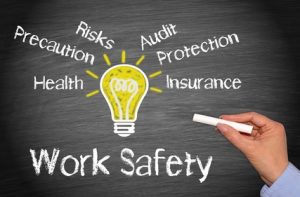Whether you are a small company or a large operation, if you employ people to work for you then you need to be fully aware of your obligations towards their safety. There have been numerous instances of companies effectively ignoring their obligations and succumbing to significant personal injury claims which can impact their cash flow, profitability and in some cases their ability to trade. We will now take a look at some of the more common causes of injury at work and how to avoid them.
 Working Environments
Working Environments
While the likes of construction sites, oil rigs, factories and farms are perhaps the more obvious dangerous working environments, the fact is that any working environment can be dangerous if it is not maintained correctly. There is an array of injuries which occur on a regular basis which include:
Construction Sector
Data from the Health and Safety Executive in the UK gives a great insight into the dangers of construction sites and how many injuries are reported each year. The latest data available covers the period 2015/16 and confirms the following:
Work-related Illness In Construction
It is estimated that per annum around 4% of workers in the construction industry suffer from what they believe to be a work-related illness. The annual average between 2013/14-2015/16 hit a staggering 79,000 self-reported work-related illnesses. Of these illnesses 64% were musculoskeletal disorders, 18% relate to stress, depression and anxiety with an additional 18% described as “other illnesses”.
Work-related Injuries In Construction
The average number of annual non-fatal workplace injuries reported between 2013/14-2015/16 is 66,000 according to the Health and Safety Executive. Using the 2015/16 data we know that 23% of injuries were due to slips, trips and falls, 22% to lifting and handling issues, 20% falls from a height and 11% were struck by an object. Even though health and safety issues have been tightened significantly in recent times, 43 fatalities were reported in the construction industry between 2015/16.
Lost Working Days In The Construction Industry
Even though much of the focus on injuries in the workplace revolves around personal injury claims, it is staggering to see how many days are lost in the workplace. Work related musculoskeletal disorders account for a staggering 1.2 million working days per year (using figures from 2013/14-2015/16). Using the same data we know that 200,000 working days were lost with other work-related illnesses, 400,000 days as consequence of stress, depression or anxiety as a result of employment and 400,000 days from a workplace injury.
Even though personal injury claims can lead to significant payouts from employers, and the need to improve safety and training, when you also take into account the lost working days the cost can be enormous. This is a cost not only to individual businesses but also the UK economy as a whole and has a significant impact on productivity numbers.
Agriculture Sector
Farms and other agricultural premises have long been one of the more dangerous working environments. Again, using data from the Health and Safety Executive we know that:
Work-related Illness In Agriculture
On average 4% of the farming/agriculture workforce suffer from what they believe to be illnesses directly relating to their work each year. The split is musculoskeletal disorders 54% and other illnesses 46% with an average 16,000 incidents reported each year (annual average between 2013/14-2015/16).
Work-related Injuries In Agriculture
Over the same period an average 15,000 non-fatal workplace injuries were reported each year. As you might have guessed, many of these injuries are specifically related to farming/agricultural activities and include slips, trips and falls at 21%, injuries caused by an animal at 15%, 15% lifting and handling, 11% falling from a height, 11% struck by an object and 9% of injuries were caused by contact with machinery.
Fatalities In Agriculture
Overall there were 27 worker fatalities in 2015/16 and a total of 152 over the last five years. The breakdown is as follows, 25 falling from a height, 18 struck by an object, 23 injured by an animal, 13 drowned or suffocated, 25 struck by a moving vehicle, 17 due to contact with machinery and 31 “other cases”. We know that the farming/agricultural workplace is one of the most dangerous and you can see from the above figures there are many ways to get injured or worse.
Manufacturing Sector
Even though the UK manufacturing sector has been decimated over the last 50 years, it is still an integral part of the UK employment market. This industry has a broader range of challenges when it comes to health and safety with thousands of illness and injury cases reported each year.
Work-related Illness In Manufacturing
We know from data provided by the Health and Safety Executive (covering the period 2013/14-2015/16), that an average 82,000 cases of work-related illnesses are reported each year. Musculoskeletal disorders accounted for 43%, stress, depression and anxiety 31% and other illness 25%. This equates to roughly 3% of the workforce and a potentially high cost to employers.
Work-related Injuries In Manufacturing
You may be surprised to learn that there were “only” an average of 66,000 (2% of the entire manufacturing workforce) non-fatal workplace injuries reported each year between 2013/14 and 2015/16. The largest group of injuries related to lifting and handling accounting for 24%, slips, trips and falls 22%, struck by an object 13% and contact with machinery 12%. During the financial year 2015/16, 27 workers were fatally injured in the UK manufacturing industry.
Lost Working Days In The Manufacturing Sector
It is estimated that an average 2.6 million working days are lost per annum due to workplace related injuries and illness in the manufacturing sector (2013/14-2015/16).
The estimated breakdown is as follows, 900,000 days because of musculoskeletal disorders, 700,000 because of stress, depression and anxiety, 600,000 due to workplace injuries and 400,000 days missed due to other work-related illness/conditions. Again, not only is this a massive cost to the industry but it also has a detrimental impact upon the overall performance of the UK economy.
Combating Workplace Injuries And Illness
Using the data available from the Health and Safety Executive we know that lost working days in the construction and manufacturing sectors total on average around 4.8 million per annum. This is often the hidden cost of workplace injury/ illness and it is amazing to think that many of these lost days could have been avoided. It would be wrong to suggest that the majority of these injuries and illnesses could be avoided but training and investment in health and safety could certainly have an impact upon the 4.8 million lost days per annum.
Perhaps the UK government needs to find a way of encouraging more investment in the workplace whether this is via tax incentives or some other kind of financial assistance. While critics might suggest this is “wasted money” targeting the private sector, we only have figures available for the construction and the manufacturing industries and they equate to 4.8 million lost working days per annum. If even 25% of these lost days could be avoided this would total 1.2 million days which would improve UK economic productivity ratios.
Startling Figures
It is only when you sit down and look at the figures that you begin to realise the impact that workplace injuries and illnesses have not only on businesses and employees but also the UK economy as a whole. Even though some companies may struggle to find sufficient funds to invest in health and safety in the workplace, perhaps we need to start looking at things in a different light?
While there may be limited short-term benefits in improved working environments the long-term benefits to companies, employees and the UK economy (and UK taxpayer) are there for all to see.
 Working Environments
Working Environments



1 comment
Grace
Hi,
This article was really interesting to read and really brought home the significance of workplace injury and the sheer amount of cases of injury due to workplace’s neglecting health and safety standards. It is so important to ensure that workplace’s comply with health and safety regulations and ensure all members are trained to the highest standard.
Great read!
Thanks,
Grace